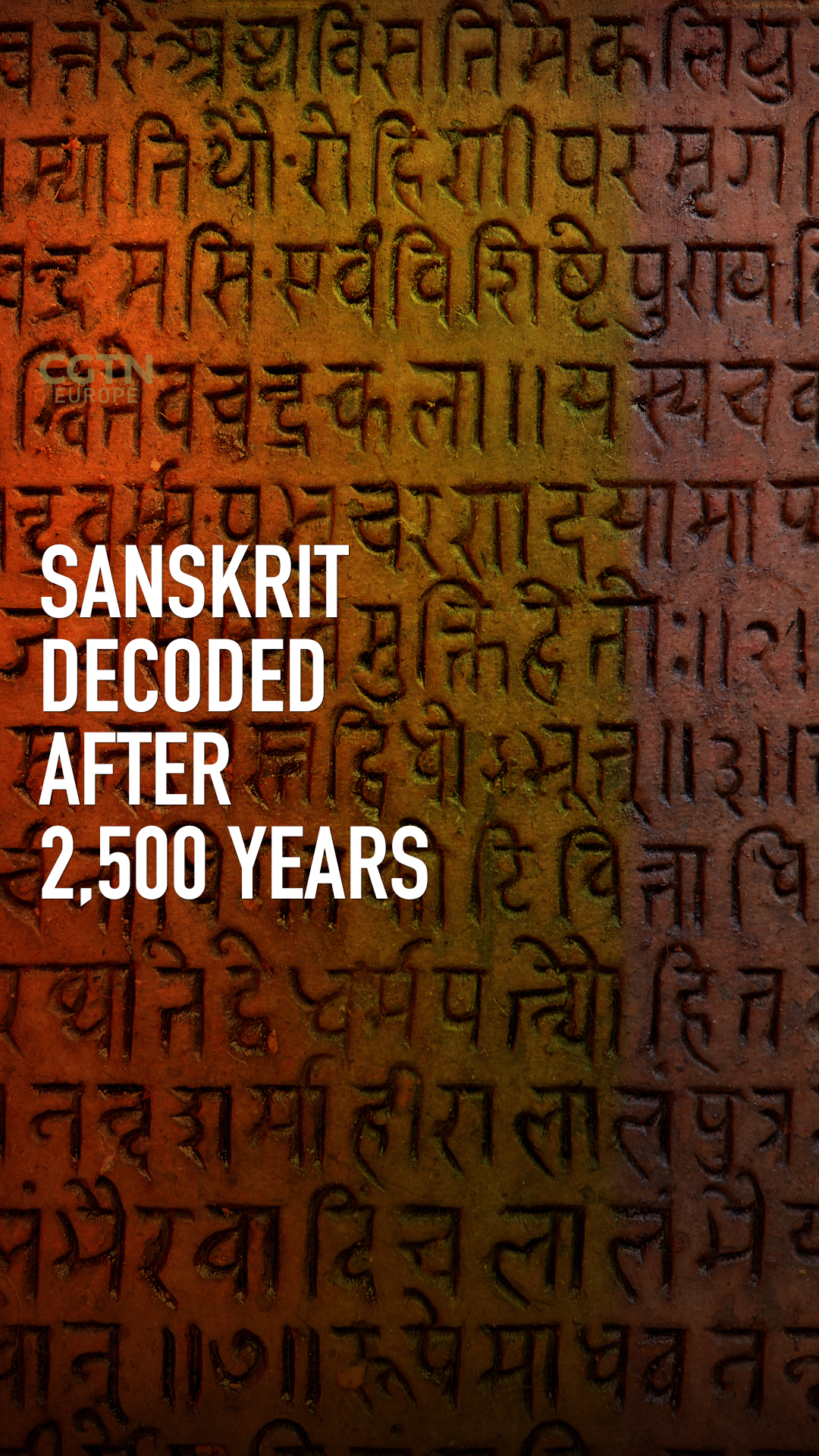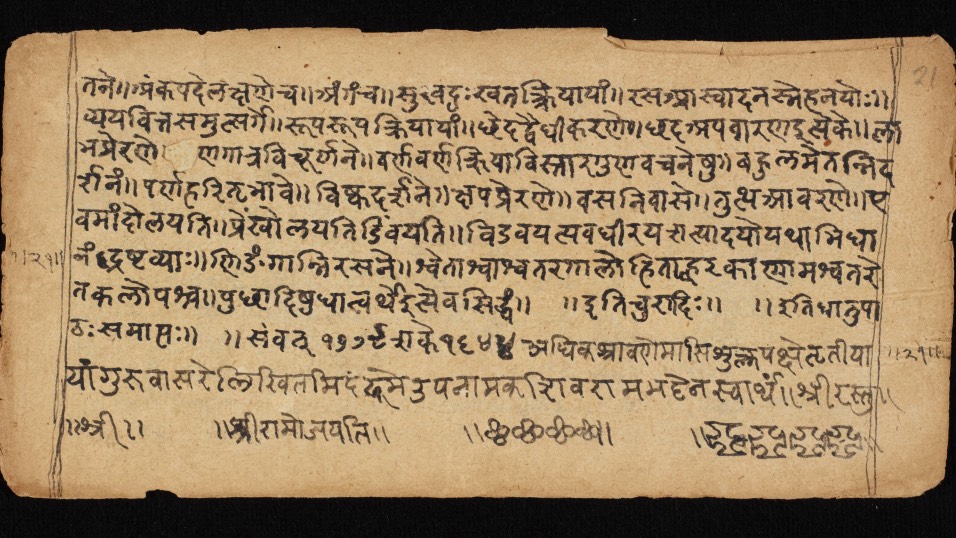01:56

A grammatical problem which has defeated Sanskrit scholars for 2,500 years has finally been solved by Rishi Rajpopat, an Indian PhD student at the University of Cambridge.
Rishi Rajpopat of St John's College has decoded a rule taught by "the father of linguistics" Panini – a Sanskrit philologist, grammarian, and revered scholar in ancient India.
Rajpopat's first brush with Sanskrit was purely coincidental, when his parents suggested that he should study it because it was one of the "high-scoring" subjects during his secondary school years. From then on, he found himself drawn to Sanskrit.
READ MORE
Why Chinese is so different to European languages
Will tech end the English language's domination?
The Secret Betrayal: China's WWII sailors
"Towards the end of my undergraduate degree, I realized that Panini was my true calling, and so I decided to stop studying economics after my bachelor's and switched to solid graduate research in this field," he told CGTN.
While researching for his PhD thesis, Rajpopat decoded the centuries-old algorithm – which makes it possible, for the first time, to accurately use Panini's revered 'language machine,' widely considered to be one of the greatest intellectual achievements in history.

Rishi Rajpopat, 27, was almost ready to quit, as he feared he was getting nowhere. /Rahil Rajpopat
Rishi Rajpopat, 27, was almost ready to quit, as he feared he was getting nowhere. /Rahil Rajpopat
The discovery makes it possible to 'derive' any Sanskrit word – to construct millions of grammatically correct words – using Panini's grammar.
Leading Sanskrit experts have described Rajpopat's discovery as revolutionary – and it could now mean that Panini's grammar can be taught to computers for the first time.
"Computer scientists working on Natural Language Processing gave up on rule-based approaches over 50 years ago", Rajpopat explained.
Panini's 'self-sufficient language machine'
Panini's system – 4,000 rules detailed in his renowned work, the Astadhyayi, which is thought to have been written around 500 BC – is meant to work like a machine. Feed in the base and suffix of a word and it should turn them into grammatically correct words and sentences through a step-by-step process.
Until now, however, there has been a big problem. Often, two or more of Panini's rules are simultaneously applicable at the same step, leaving scholars to agonize over which one to choose.
In an attempt to fix this issue, many scholars laboriously developed hundreds of other metarules, but Rajpopat's research shows that these are not just incapable of solving the problem at hand, they all produced too many exceptions, which are also completely unnecessary.
It also confirms that Panini's language machine is 'self-sufficient.'
"Panini had an extraordinary mind and he built a machine unrivaled in human history," said Rajpopat. "He didn't expect us to add new ideas to his rules. The more we fiddle with Panini's grammar, the more it eludes us," said the scholar.
Traditionally, scholars have interpreted Panini's metarule as meaning: In the event of a conflict between two rules of equal strength, the rule that comes later in the grammar's serial order wins.
Rajpopat rejects this, arguing instead that Panini meant that between rules applicable to the left and right sides of a word respectively, Panini wanted us to choose the rule applicable to the right side.
This is a major milestone in the history of human interaction with computers.
- Rishi Rajpopat, Sanskrit scholar
Employing this interpretation, Rajpopat found Panini's language machine produced grammatically correct words with almost no exceptions.
"And coupled with the intention of the speaker, this grammar can help us produce Sanskrit sentences… human speech, essentially. I think this is a major milestone in the history of human interaction with computers."
As Rajpopat struggled to make progress, his supervisor at Cambridge, Vincenzo Vergiani, Professor of Sanskrit, gave him some prescient advice: "If the solution is complicated, you're probably wrong."
Rajpopat acknowledges he could not have done it without the support of his supervisor. Vergiani challenged him when necessary, but more importantly gave him "the intellectual freedom that was necessary to try to achieve something of this sort."

A page from an 18th-century copy of the Dhaatupaaṭha of Panini held by Cambridge University Library. /Cambridge University Library
A page from an 18th-century copy of the Dhaatupaaṭha of Panini held by Cambridge University Library. /Cambridge University Library
'Hidden from everyone's minds'
The 27-year-old was almost ready to quit, as he believed he was getting nowhere. So he decided to spend a month away from his books and just enjoyed the summer, swimming, cycling, cooking, praying and meditating.
"Then, begrudgingly I went back to work, and, within minutes, as I turned the pages, these patterns started emerging, and it all started to make sense," recalls Rajpopat.
"I opened the first notebook and I started flipping pages and observing a pattern and noticing that a certain rule – the rule that is applicable to the right-hand-side part of the word – always wins when there is a conflict between these two rules which are simultaneously applicable."
At that moment, he realized that he had found the solution.
"I thought to myself, in utter astonishment: For over two millennia, the key to Panini's grammar was right before everyone's eyes but hidden from everyone's minds!"
He realized there was a lot more work to do but he knew he had found the biggest part of the puzzle.
I felt really fortunate that of all the people, I was the one who was able to crack this code.
- Rishi Rajpopat, Sanskrit scholar
Over the next few weeks he spent his days and nights in the library to check what he had found and solved related problems.
That work took another two-and-a-half years.
"I realized I was one of many scholars at Cambridge who work on these kinds of topics. So, I felt really fortunate that of all those people, I was the one who was able to crack this code," Rajpopat said.
Key to 'most ancient wisdom of India'
Sanskrit is an ancient and classical Indo-European language from South Asia. It is the sacred language of Hinduism, but also the medium through which much of India's greatest science, philosophy, poetry and other secular literature have been communicated for centuries.
"Some of the most ancient wisdom of India has been produced in Sanskrit and we still don't fully understand what our ancestors achieved," Rajpopat said.
While only spoken in India by an estimated 25,000 people today, Sanskrit has growing political significance in India, and has influenced many other languages and cultures around the world.
"This discovery will revolutionize the study of Sanskrit at a time when interest in the language is on the rise," Vergiani said.
Rajpopat hopes this discovery will infuse students in India with confidence, pride, and hope that they too can achieve great things.
"Panini was working on this at a time when surely he had fewer resources than we do today, and yet he was able to achieve something so absolutely spectacular.
"So, I think our youth can be fairly sure that if we work hard and if we have faith in ourselves, then we can achieve some very amazing things as well."
Video editor: Butchy Davy